Librarians and Older Technology Part 1: Microforms
Miriam Kahn, MLS, PhD
Older formats of photography, sound, and moving images are often stored in archives, historical societies, and records centers, as discussed in my last post about skills for special librarians and obsolete technologies. The intellectual contents stored in these formats are rich and varied and may be the only remaining ‘copy’ of a publication, image or audio file that’s no longer otherwise available.
In order to determine whether these formats remain of value to an individual organization and its users, it’s necessary to identify the intellectual contents, confirm the subject matter fits within collection policies and mission statements, and determine that the physical medium is stable and useable.
Four types of older formats
While historical societies and archives may have researchers interested in studying the physical objects themselves, most researchers are interested in the data contained within or upon each reel, roll, or sheet. There are four main types of media: microforms, audio, video, and photograph prints and negatives. My next four blog posts will discuss each type in depth and provide resources for additional research and reference.
Microforms
Microforms are a subset of photographs. They are common in information centers and exist in the fewest formats.
Photography, as you’ll recall, begins in 1839. Almost immediately after its invention, scientists and technologists harnessed the technology to document small and large objects, including microbes and stars respectively.
Microfilm
Microfilm, a flexible film with reduced images that can be printed out to “original” size, was an invention of the twentieth century . By early 1930s, Eugene Power, the most prominent inventor of microfilm, founded University Microfilms (UMI) and set about filming and distributing copies of early books, manuscripts, and most importantly scholarly publications such as dissertations and theses. He was also responsible for developing equipment for reading microfilm and producing print copies for researchers. By microfilming documents and storing the originals, UMI made copies on demand of microfilm and paper printouts.
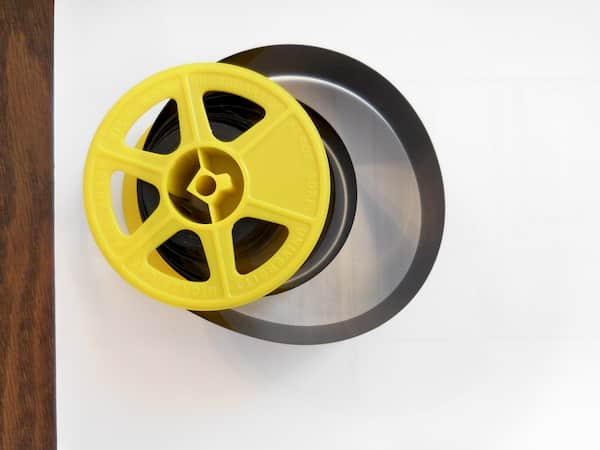 |
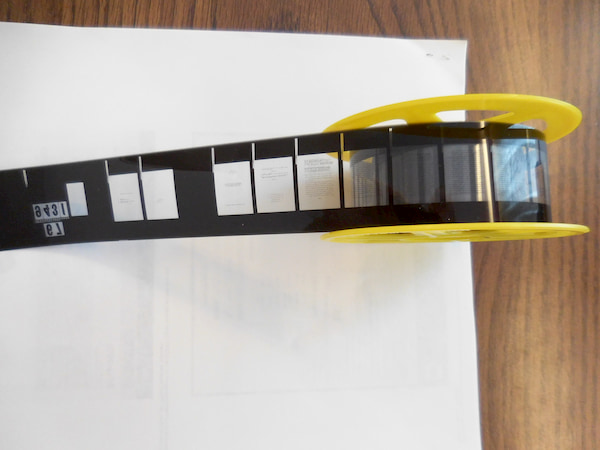 |
|---|
Microfilm was also used to capture manuscript and archival collections. This ensured against the loss of unique items by making multiple film copies available to researchers. As the process evolved and the acuity of cameras improved, microfilm was used to capture newspapers, journals and magazines, as well as the multitude of business records from checks to insurance policies.
The standard size of microfilm is 35mm. This size was used for filming most bound print materials and provided the best resolution for reading off the film. This is the film size used in preservation projects. Business records, catalogs, checks, and other records were often filmed on 16mm. The smaller format was often used for paper records.
Microfiche
Microfiche is a 3”x5” sheet of film (105 x 148 mm). Some microfiche was made from microfilm by cutting strips of 16mm microfilm and printing them onto fiche. At the same time, photocopier-type machines were developed that printed documents directly onto microfiche film stock and output the sheets for users. This printing and output technology was also adapted by companies that used computer data to compile catalogs and data and output it to microfiche, which is called Computer Output Microfiche (COM).
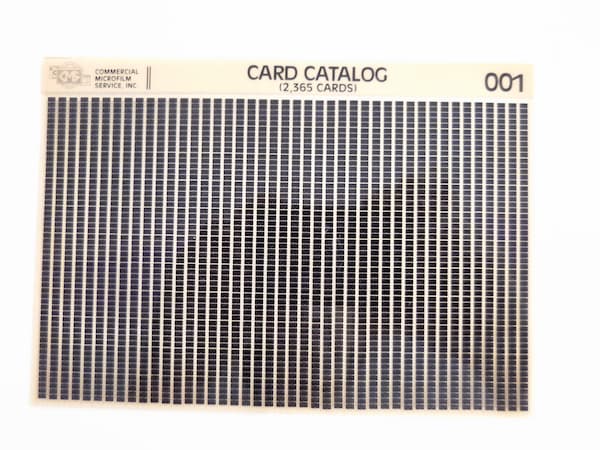 |
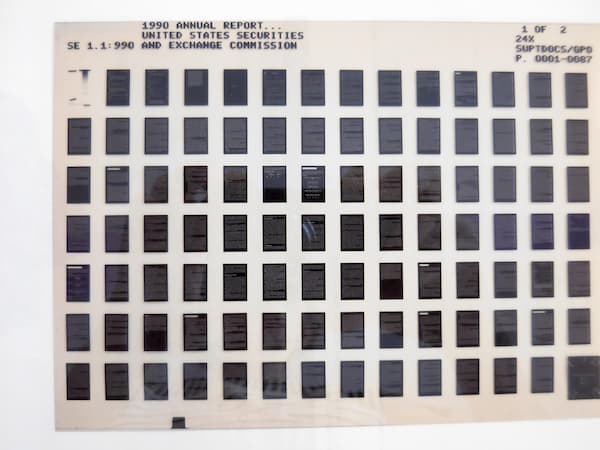 |
|---|
You’ll find fiche in government documents, record centers, and court houses, as well as archives and information centers.
Aperture cards
Maps and atlases, engineering and architectural drawings were often filmed at reduced ratios and made available on microfilm, microfiche, and aperture cards. The latter are single frames of microfilm mounted onto a Hollerith card with a window for viewing the large drawings and renderings. The cards contain information about parks, sub-developments, and buildings. Aperture cards are commonly found in record centers, court houses, engineering departments, and mapping offices.
Photofiche
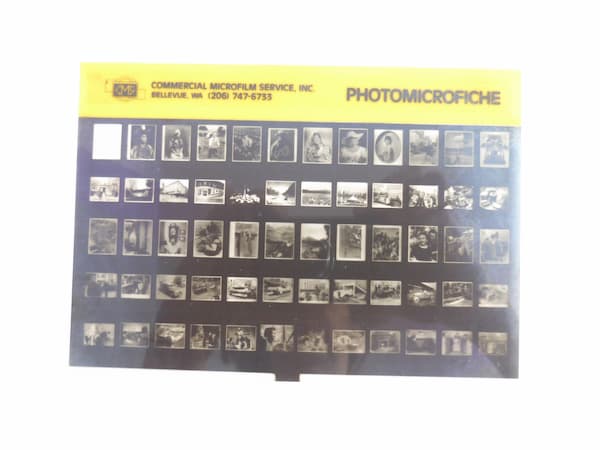
This high resolution film was used to capture works of art including paintings and photographs. This film is recognizable by its content and for the variable sizes of the images on the sheet of fiche. It is the forerunner of early analog image capture that was output on laser discs in the 1980s, before digital capture existed or was cost effective.
Micro-cards or micro-opaque cards
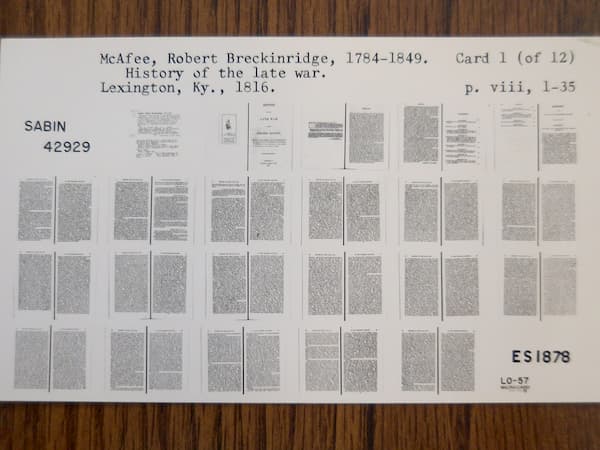
Micro-cards or micro-opaques are easily recognizable. The photographic images are printed onto card stock instead of film stock. The cards usually have cataloging information on them, everything you would expect on a standard twentieth-century catalog card, i.e.: author, title, subject tracings, call numbers.
Reduced images of the book, journal, or documents are laid out in rows and columns just like microfiche. Invented in the 1930s and used originally by the American Antiquarian Society to reproduce Early American Imprints, micro-cards will also be found containing published works, treaties, and some government documents.
Producers and distributors of microform sets
The Government Printing Office filmed and distributed Federal Depository items on microfilm and microfiche until they adopted CD-ROM technology in the late 1980s.
Documentary Editing Projects supported by NHPRC and academic and library cataloging projects including Early English Books and Early American Imprints, papers of the Founding Fathers and Early Republic among others.
The National Endowment for the Humanities initiated preservation microfilming projects beginning around 1986. Academic consortia worked together to microfilm and preserve brittle books in all subject areas and disciplines. These books and journals were filmed to high, preservation standards and output onto 35mm film.
The National Archives of the United States, beginning in the 1930s, used 35mm film to capture the manuscript (original) census records, those used most heavily by genealogists and historians. Other organizations and cooperative consortia across the globe use microfilm and fiche to capture records, manuscripts, and printed materials from every era and language.
Newspaper and journal publishers used 35mm film to capture the pages of their newspapers, especially as the physical paper began deteriorating.
Today, digital technology is used to capture images, print, manuscript materials and three-dimensional objects. Microfilm is produced from the digital scans and stored as backups, legal surrogates, and research copies. Microfilm from digital scans is often found in government records, courthouse documents, and court records.
Storage
Master negatives of microfilm and microfiche should be stored off-site in an appropriate environment meeting preservation standards. Most of the master negatives today are stored in Iron Mountain Underground Storage in PA. Use copies should be stored in metal cabinets in cool, dry conditions 65-68 degrees F with relative humidity 35-50%. Off-gassing should be monitored.
Microfilm should be stored upright on its reels while fiche and micro-cards should be stored in upright in drawers.
Reading the images
Microfilm and microfiche readers or reader-printers are commonly found in information centers, archives, historical societies, and museums. The equipment consists of light and magnification. Output to paper is most common although most machines today will also output to PDF and other digital formats.
Newer computerized microfilm and fiche readers are fancy scanners that output the filmed images into PDFs. Special attachments and programs are necessary for reading and output of the images captured on micro-opaque cards.
Summing it up
Microfilm, fiche, and micro-opaque cards were used to capture images, printed materials, manuscripts, archival documents, and government records beginning as early as the 1920s and ‘30s. The intellectual contents on microforms are rich and diverse and may be the only remaining ‘copy’ of a publication that’s no longer in print. The technology needed to access, read, and output the content of microforms is simple: light, magnification, and projection.
Use standard collection policy criteria when deciding upon retaining microform collections, keeping in mind the originals may no longer exist—and that the resolution or images may be better than digital images made from film.
Want to know more about microforms?
Luther Frederic, Microfilm: A History 1839-1900 (Annapolis, MD: The National Microfilm Association, 1959).
August A. Imholtz, Jr., “Albert Boni: A Sketch of Life in Micro-Opaque” Proceedings of the American Antiquarian Society. 115 Pt. 2 (2005): 253-277.
Miriam Kahn, “Archival Copies: An Evolutionary Journey” Journal of Archival Organization 15 No. 1-2, 2018.
Eugene B. Power, Edition of One: The Autobiography of Eugene B. Power Founder of University Microfilms (Ann Arbor: University Microfilms, Inc., 1990)
My next blog post will look at common audio recording formats and technologies found in record centers, archives, historical societies, museums, and libraries.
1 For more definitions and types of microforms, see: A Glossary of Archival and Records Terminology, Chicago: Society of American Archivists, 2005.
https://www2.archivists.org/glossary/terms/m/microfilm
Miriam Kahn, MLS, PhD
Miriam B. Kahn, MLS, PhD provides education and consulting for libraries, archives, corporations, and individuals. See Miriam’s pieces for Lucidea covering library technology and skills for special librarians. Also check out SydneyEnterprise, and GeniePlus, Lucidea’s powerful integrated library systems.
Similar Posts
Teaching about AI in the Workplace
Suggestions for special librarians from Claude on how to foster cross-generational AI learning communities in the workplace.
Keeping up with AI…
Resources for staying current on the quickly changing AI landscape from a library expert.
Interview with Lesley Farmer about SLA’s Information Outlook
Interview about the rebirth of SLA’s Information Outlook as a quarterly online publication with interview with Professor Lesley Farmer
Ways I Have Been Using Generative AI
Generative AI can be used in many ways as part of a typical workflow; examples and thoughts about what the future holds




Leave a Comment
Comments are reviewed and must adhere to our comments policy.
0 Comments